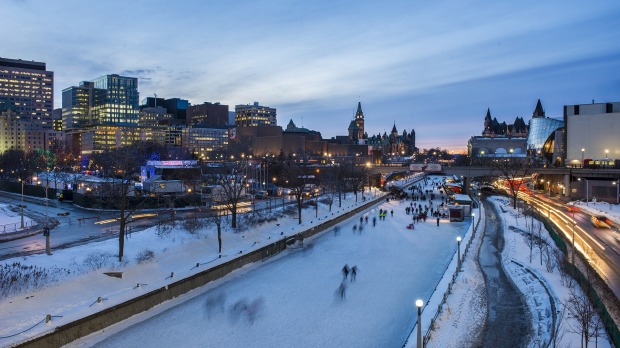
It is said by some that Ottawa is the world's second coldest national capital, following only Ulan Bator, of Mongolia. This is impossible to verify: Are we talking average temperature or record temperature? Either way, the sentiment feels accurate. Ottawa, Canada, is certainly the coldest city I've ever visited, and the only place I've seen car exhaust hanging in the air like a dense fog, unable to dissolve in minus 31 degrees Celsius.
If Ottawa were an Australian city, everybody would grumble about the cold. If it was a British city, things would be worse: People would refuse to leave their houses at all, like a nation of wild-eyed recluses. If Ottawa was an American city, re-positioned slightly south, everyone would be outwardly pleasant about the weather, but secretly bitter; and then somebody would slip on an sidewalk and there would be a class-action lawsuit against Mother Nature.
But Ottawa, being Canadian, is an all-round genial kind of place. Ottawans approach their meteorological situation as only Canadians can: with a buoyant attitude almost childlike for its lack of sarcasm. Fathers hose puddles in their backyards, which freeze into private rinks. ("It's great for kids," one woman tells me. "Better than playing video games!") Farmers' markets sell winter fare like Tibetan yak, encouraging customers to "enjoy the sublime taste of ancient beasts, so nutritious and easy to digest". Office workers skate to work on a frozen canal, transforming inconvenience into a morning workout.
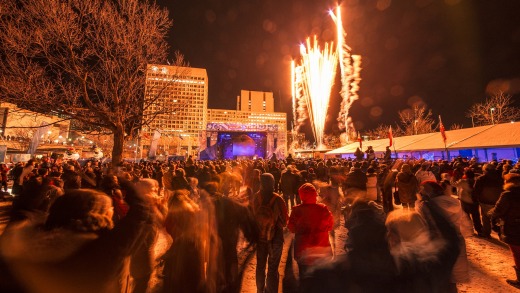
Actually, this determination to make something positive out of disadvantage is part of Canada's historical character: the country once harvested ice blocks and shipped them to Cuba and India; and the snow shoe, as one museum explains, is not an encumbrance but "a symbol of courage and adventure and reminds us of those who founded our beautiful country by walking on thousands of kilometres of snow".
I am fascinated by this positivity. It seems so alien –– so impossible. Do they really mean it when they write "This is why I love winter!" on a brochure above a picture of a family wearing 75 layers of clothing?
Recently, my curiosity got the better of me: upon learning that Ottawa actually celebrates winter with an annual three-week festival called "Winterlude," I decided to buy a fur-trimmed parka and fly in to investigate.
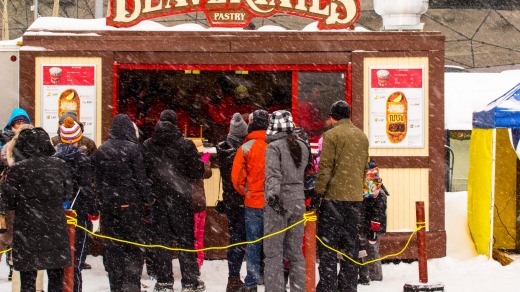
Winterlude was started in 1979 and it now attracts more than a million visitors each year during February. Many of the city's cultural institutions get involved, including the Canadian Museum of Nature, with its new "Arctic Voices" exhibition spotlighting Canada's arctic environment; and the National Gallery, which curates a "Wintry Journey" through the collection. The mascots for the festival are the "Ice Hog Family" –– Mama and Papa Ice Hog, and their children, Noumi and Nouma. According to official literature, the Hogs "love everything about winter: the snow, the wind, the cold. Every year, they hold a great celebration to say goodbye to winter and remind it to come back and play again next year. Sometimes they spend weeks playing games, dancing and holding competitions". The Hogs live in Jacques-Cartier Park, in Gatineau, which transforms during the festival into "Snowflake Kingdom" a sprawling theme park of snow slides and maple taffy that seems to send children into paroxysms of delight, though perhaps that is just the sugar.
But the centre of events is actually Federation Park, just across the street from my downtown hotel. On my first morning in Ottawa, I drink copious amounts of coffee and then go outside into a chill so sharp ice sculptures around the city are perfectly intact, despite being carved nearly a week earlier. Federation Park has been temporarily renamed the "Crystal Garden" and it is filled with these mind-bending creations: amateur and professional ice carvers have come together to compete in a series of competitions around the theme of "play". I walk past snowmen and divers; cowboys and caribou; and what appears to be the little orphan Annie crossed with Regan from The Exorcist. The ice works are huge and intricate, glittering like something pulled up out of the Arctic. The crowd is thrilled by these statues, snapping photos in every direction as they munch steaming Beavertail pastries.
On the far side of the park is a stretch of the Rideau Canal, the 202-kilometre waterway connecting Ottawa with Lake Ontario in the south. Each winter for the last 45 years, about seven kilometres have been buffed and polished into the world's longest skateway, which cuts right through the city. There is no admission charge and, though most locals prefer to bring their own boots, the rest of us can stagger across to a small hut where rentals are sharpened on a spinning stone that sounds like a meat slicer.
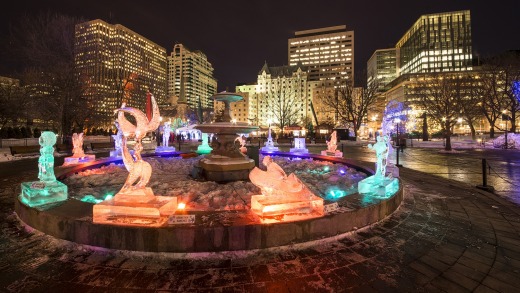
Within 10 minutes, I'm gliding beneath bridges and past residential neighbourhoods, feeling liberated in a way that I hadn't quite expected. School kids are practising relays along the ice and a Japanese woman skates behind an office chair, which she occasionally turns around to sit on and rest. Populating the canal is a full cross-section of Ontario, excluding no demographic or skill level. Everybody is here, fooling around together and there's no shame in moving your body like a brutalist art piece, all angles and inelegant jutting.
Eventually I make it all the way to Dow's Lake, where the canal widens before continuing south. Dow's Lake is the location of Winterlude's oddest event: the 35th Annual Accora Village Bed Race. "Which bed will be the fastest?" I hear somebody ask in the crowd. Then I catch sight of modified hospital beds, lined up behind a starting line in the middle of the lake ice. Each bed decorated like a tank or pinata, for example, and all contestants are dressed to draw attention. One team has open-backed gowns with fake derrieres. "Avert your eyes," the announcer warns. "I see many a bare bum on the ice." Moments later they are off, screaming down the lake as though we were in a psychedelic emergency room.
Winterlude is full of these kind of shenanigans. One day I drop by the ByWard market for lunch, and notice a plump white tent where a "stew cook-off" is under way.
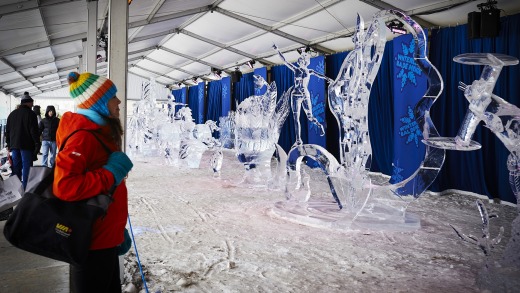
"Ten dollars, 23 stews," yells a man by the door.
"Vegetarian?" asks a woman.
"None!"
I grab a bowl and enter the tent, then move around the stalls like Oliver Twist, asking for more cassoeula Milanese, more chicken and rib gumbo, more crab corn double smoked bacon stew, and more shepherd's hamburger stew –– whatever that is.
"These are students," a man instructs me carefully, gesturing at two young girls wearing white hats and holding their ladles like weapons. "They take it very seriously. This is the best." One of the girls fills my bowl with steaming prime ribs; the other places a sweet potato flake on top with the dainty precision of a sous chef in a Michelin star restaurant.
In fact, fine dining comes later, in the evening. Many restaurants around Ottawa offer a dedicated Winterlude menu for reasonable prices but the Courtyard Restaurants takes things one step further, offering an Annual Canadian Game Dinner. Over the course of several hours I eat pheasant terrine, boar bacon, elk strip loin and roast North Pacific black cod with hash-brown potato. The executive chef, Ian Reed, is a young tattooed man with slicked-back hair and a denim shirt. "The ideas are always flowing," he tells me, as a waiter delivers Canadian maple sugar pie and my pants begin to split from the strain.
There is more to come in Winterlude –– a winter design festival, a chocolate tour, "martinis and manicures", open-mic in one of the many Irish-style pubs –– but the temperature drops so drastically that I feel compelled to scuttle back to my hotel like a hermit crab.
The route takes me back across the Rideau Canal, still crowded with skaters despite the dark; and through Federation Park's Crystal Garden, which seems even more energised than it did in the morning. All the sculptures are back-lit with coloured lights now. There is a thump-thump of bass music and people laughing before a DJ on the stage. Surely this is the ultimate sign of Canadian defiance: a dance party in sub-zero temperatures. People genuinely seem to love the weather. It's impossible not to be charmed as well, so I linger for a moment, warming my hands around a fire pit. And then I go inside.
www.canada.travel
www.ottawatourism.ca
Air Canada flies from Sydney direct to Vancouver and then on to Toronto. It also has connections to Ottawa; see aircanada.com. Another good way to move between Toronto and Ottawa is with the efficient and well-serviced VIA Rail. See www.viarail.ca.
Winterlude runs for three weeks from the very end of January into February. Events are scheduled every day, though highlights occur on the weekend. See www.winterlude.ca.
Like Ottawa, Toronto marks its winter season with a celebration called "Winterlicious," which involves special prix fixe menus at more than 200 restaurants. Here are five of the best. www.winterlicious.ca.
A dining room made from Douglas fir would mark Frank as something special even if it wasn't designed by Frank Gehry for the Art Gallery of Ontario. www.ago.net/frank
An Italian steakhouse, Michael's on Simcoe has a well-deserved reputation for its cured meats and bone-in black Aberdeen angus. www.michaelsonsimcoe.com.
One of Toronto's most popular restaurants, Nota Bene spotlights local and seasonal produce in dishes like a "farm to fork" charcuterie. www.notabenerestaurant.com.
David Chang has expanded his culinary empire to Toronto, and Momofuku Daisho is the perfect place for shared plates of simple but perfectly executed Japanese fare. www.momofuku.com/toronto/daisho.
Having made waves for its remarkable design, America Restaurant justifies the hype with a menu emphasising exquisite seafood. www.americarestaurant.ca.